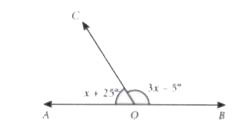Which of the following options is correct :-
A pair of adjacent angles have.
(i)Common vertex
(ii)Common Arm.
(iii)Non Common arms are an opposite sides of common arms.
(iv)Non Common arms are on the same side of common arms.
(i) & (ii) are sufficient
(i),(ii) & (iii) are sufficient
(i) ,(ii) & (iv) are sufficient
All are sufficient
The correct Answer is:B
To determine which of the given options is correct regarding a pair of adjacent angles, let's analyze each option step by step.
Step 1: Understand the Definition of Adjacent Angles
Adjacent angles are two angles that share a common vertex and a common arm (side), while their non-common arms are on opposite sides of the common arm.
Step 2: Analyze Each Option
1. Option (i): Common vertex
- Explanation: For two angles to be adjacent, they must share a common vertex.
- Conclusion: This option is correct.
2. Option (ii): Common Arm
- Explanation: Adjacent angles must have one arm in common.
- Conclusion: This option is correct.
3. Option (iii): Non-common arms are on opposite sides of common arms
- Explanation: The non-common arms of adjacent angles must be on opposite sides of the common arm.
- Conclusion: This option is correct.
4. Option (iv): Non-common arms are on the same side of common arms
- Explanation: This statement contradicts the definition of adjacent angles, as the non-common arms must be on opposite sides of the common arm.
- Conclusion: This option is incorrect.
Final Conclusion
The correct options are (i), (ii), and (iii). Option (iv) is incorrect.
Summary of Correct Options
- (i) Common vertex: Correct
- (ii) Common arm: Correct
- (iii) Non-common arms are on opposite sides of common arms: Correct
- (iv) Non-common arms are on the same side of common arms: Incorrect
Adjacent angles are two angles that share a common vertex and a common arm (side), while their non-common arms are on opposite sides of the common arm.
1. Option (i): Common vertex
- Explanation: For two angles to be adjacent, they must share a common vertex.
- Conclusion: This option is correct.
- Explanation: Adjacent angles must have one arm in common.
- Conclusion: This option is correct.
- Explanation: The non-common arms of adjacent angles must be on opposite sides of the common arm.
- Conclusion: This option is correct.
- Explanation: This statement contradicts the definition of adjacent angles, as the non-common arms must be on opposite sides of the common arm.
- Conclusion: This option is incorrect.
The correct options are (i), (ii), and (iii). Option (iv) is incorrect.
- (i) Common vertex: Correct
- (ii) Common arm: Correct
- (iii) Non-common arms are on opposite sides of common arms: Correct
- (iv) Non-common arms are on the same side of common arms: Incorrect
Topper's Solved these Questions
- BOOK - CBSE COMPLEMENTARY MATERIALCHAPTER - LINES AND ANGLESEXERCISE - PART-B12videos
LINES AND ANGLES
- BOOK - CBSE COMPLEMENTARY MATERIALCHAPTER - LINES AND ANGLESEXERCISE - PART-C16videos
LINES AND ANGLES
- BOOK - CBSE COMPLEMENTARY MATERIALCHAPTER - LINEAR EQUATIONS IN TWO VARIABLES EXERCISE - PRACTICE TEST12videos
LINEAR EQUATIONS IN TWO VARIABLES
- BOOK - CBSE COMPLEMENTARY MATERIALCHAPTER - NUMBER SYSTEMSEXERCISE - Part - D18videos
NUMBER SYSTEMS
Similar Questions
In a pair of adjacent angles, (i) vertex is always common, (ii) one arm is always common, and (iii) uncommon arms are always opposite rays
ThenView SolutionAssertion : The value of x in the following figure is 40°.

Reason: A linear pair is a pair of adjacent angles whose non-common arms are opposite rays.View Solution
Knowledge Check
- Question 1 - Select One
Which of the following is correct for the common cockroach ?
AMalpighian tubules are excretory organs projecting out from the colonBOxygen is transported by haemoglobin in bloodCNitrogenous exretory product is ureaDThe food is grinded by mandibles and gizzard - Question 2 - Select One
Which of the following centre pairs had common serial number candidates ?
A83 and 65B56 and 65C85 and 83D48 and 65 - Question 3 - Select One
Which of the following pair of evidences indicates the common ancestry ?
AHomologous organs&analogous organsBHomologous organs & vestigeal organsCAnalogous organs & vestigeal organsDBoth (A) and (C)
If the sum of the two adjacent angles is 180∘; then their non-common arms are two oppposite rays.
View SolutionLINEAR PAIR Two adjacents angles are said to form a linear pair of angles if their non-common arms are two opposite rays.
View SolutionWhich of the following contraceptive devices is having a common mechanism of action?
View Solutionfill in the blanks to make the statements true.
Adjacent angles have a common vertex, a common __________ and no common _________.View SolutionWhich of the following features does all gas exchange have in common?
View Solution
